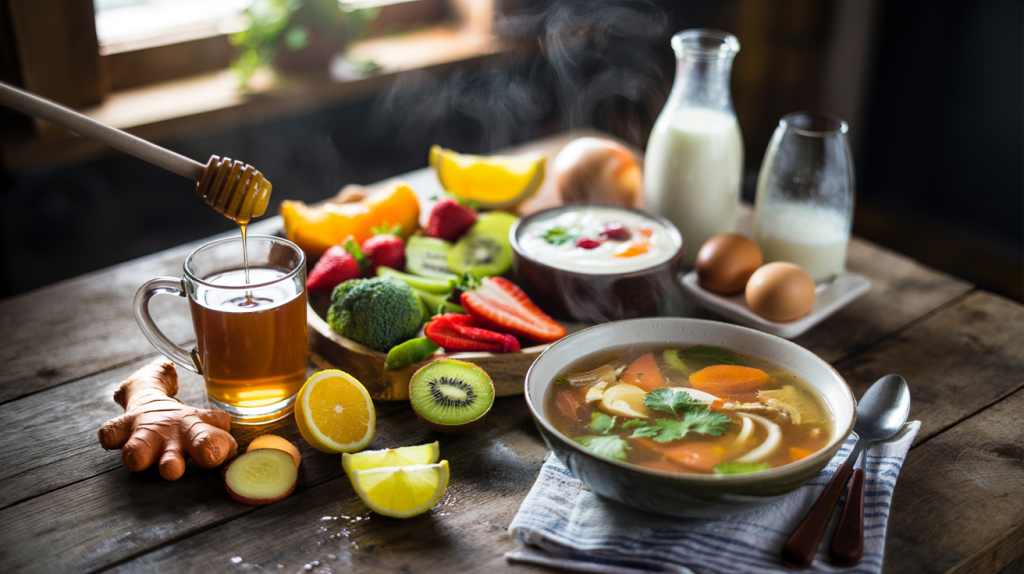Blocked nose, raw throat, zero energy. When a cold hits, the kitchen can become a toolkit. Good news : some everyday foods and drinks do help shorten symptoms or make them easier to live with.
The essentials show up fast in the data : vitamin C foods, zinc lozenges started early, honey at bedtime, soothing chicken soup, probiotic yogurt, and warm ginger tea. Adults catch 2 to 3 colds each year while kids get more, so picking the right plate matters now (Source : CDC, 2024). Vitamin C can trim duration by 8 percent in adults and 14 percent in children with regular use (Source : Cochrane Review, 2013 updated 2018). Zinc lozenges started within 24 hours cut colds by about one-third in trials (Source : Open Forum Infectious Diseases, 2017). Honey eases night cough in children older than 1 year (Source : Pediatrics, 2012).
Best foods for a cold : what really helps
Here is the core idea : food will not cure a cold, but the right choices can ease symptoms, support hydration, and shave off sick days.
Colorful produce first. Oranges, kiwis, strawberries, bell peppers and broccoli pack vitamin C alongside fluids. The evidence points to a modest but real reduction in cold duration with daily vitamin C, especially for kids or those under physical stress (Source : Cochrane Review, 2013 updated 2018).
Fermented dairy and fermented vegetables bring probiotics. A review found fewer and shorter upper respiratory infections in people taking probiotics compared with placebo (Source : Cochrane Review, 2015). A small daily yogurt or kefir fits easily when appetite is low.
Classic chicken soup is not just comfort. Laboratory work showed it can reduce neutrophil movement, suggesting a mild anti‑inflammatory effect that may ease congestion (Source : Chest, 2000). Warm steam and salt also help clear the nose, meal after meal.
Fatty fish, eggs, and fortified milk add vitamin D. A 2017 meta‑analysis reported a modest 12 percent lower risk of acute respiratory infections with vitamin D supplements overall, larger in people who were deficient (Source : BMJ, 2017). That is prevention more than treatment, yet useful in winter.
Vitamin C, zinc, honey and chicken soup : what studies say
Vitamin C works best as a daily habit of at least 200 mg, not as a last‑minute megadose. Regular supplementation reduced cold duration by 8 percent in adults and 14 percent in children, but did not stop most colds from happening in the general population (Source : Cochrane Review, 2013 updated 2018). High doses can cause stomach upset, and very high amounts long term are not wise.
Zinc helps when timing and form are right. Randomized trials using zinc acetate lozenges providing around 75 to 95 mg elemental zinc per day for a few days shortened cold duration by roughly 33 percent if started within 24 hours of symptoms (Source : Open Forum Infectious Diseases, 2017). Skip intranasal zinc sprays because of smell loss concerns flagged in 2009 (Source : U.S. FDA, 2009). Nausea is common, and long runs of high‑dose zinc can disturb copper balance.
Honey stands out for night cough in children. In a controlled study, a single bedtime dose of buckwheat honey improved cough and sleep more than no treatment and performed similarly or slightly better than dextromethorphan (Source : Pediatrics, 2012). Never give honey to children under 1 year because of botulism risk.
Chicken soup remains a solid, warm, salty, protein‑plus‑veg option when nothing else sounds good. The 2000 study did not measure days sick, but the lab signal and real‑world comfort keep it on the table (Source : Chest, 2000).
Easy meals and drinks to soothe a cold
Small, frequent bites feel doable when appetite dips. Keep it simple and warm.
- Chicken soup with carrots, celery, onion and garlic : hydration, sodium for rehydration, protein for repair.
- Yogurt parfait with kiwi and berries : probiotics plus vitamin C in one bowl.
- Citrus and bell pepper salad with olive oil : bright, crunchy vitamin C with healthy fat.
- Ginger‑lemon‑honey tea : warmth for sore throats, gentle sweetness for cough relief.
- Oatmeal topped with chopped nuts and sliced banana : soft carbs for energy, minerals for recovery.
- Spicy tomato broth with chili and a squeeze of lime : steam for the nose, light yet satisfying.
- Water, herbal tea, or diluted fruit juice : steady sips to avoid dehydration when fever hits.
Common mistakes, safety tips, and when to get medical advice
Easy trap : waiting too long to start zinc. If choosing lozenges, begin within 24 hours and keep total elemental zinc near trial ranges for only a few days. Intranasal products are off the list.
Another one : megadosing vitamin C or gulping sugary drinks. Large spikes bring stomach cramps without extra benefit, and excess sugar can irritate a sore throat. Dairy is fine for most people; if mucus feels thicker after a milkshake, switch to yogurt.
Alcohol dehydrates, so skip it until sleep and hydration return. Rest counts as much as recipes. Yes, naps definetely help.
Time to call a clinician if red flags show up : shortness of breath, chest pain, confusion, dehydration, high fever above 38.5 °C lasting more than 3 days, symptoms that worsen after day 5, or no improvement by day 10. For infants under 3 months, any fever needs urgent care. People with chronic heart, lung, or immune conditions should seek early guidance (Source : CDC, 2024).
One last gap to close : vitamin D status. If winters are long or sun is scarce, ask about testing and food sources. A small daily supplement may cut respiratory infection risk in those who are low (Source : BMJ, 2017). Combine that with citrus, soup, probiotics, and an early zinc plan, and recovery gets shorter and gentler.
